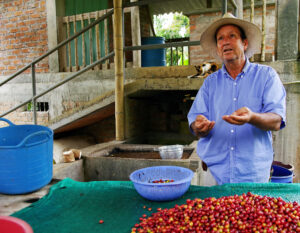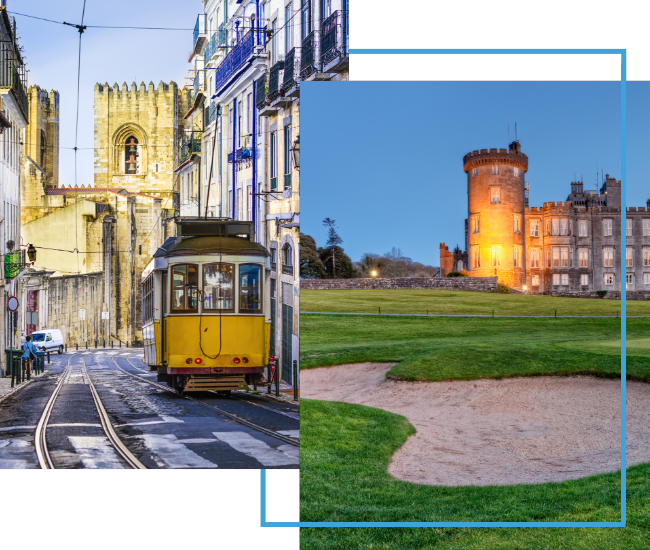A young man in traditional, loose-fitting clothing and a straw hat arranges a cloth filter over a metal pitcher and carefully measures out the right number of scoops. He pours steaming water over the grounds as we look on with anticipation. When it has all flowed through, he pours the black liquid into mugs that warm our hands in the morning mountain mist. We take sips and smile, drinking coffee from the source that tastes nothing like what comes out of a pot at the local diner.
We’re finishing up a farm tour in Colombia, one of the world’s best-known coffee-producing countries and one whose top farms win tasting awards on an annual basis. A whole Coffee Triangle region comprises the cities of Armenia, Pereira and Manizales. There’s even an amusement park with entertainment in this area that’s dedicated to the world’s most popular beverage: Parque Nacional del Café.

© RECHITAN SORIN | DREAMSTIME.COM
We had just toured the farm and saw where the “cherries” turn from green to red on the bushes as they ripen. Our guide led us to the area where the beans are dried in the sun and then readied for export. A roaster prepares the ones that stay in Colombia, then a grinder gets them ready for tastings like ours.
This kind of experience is not unique to Colombia. I’ve toured coffee farms throughout the Americas, including a large, famous producer in Costa Rica and a boutique operation in Panama, Finca la Milagrosa, where the roasting equipment was made from used junkyard parts like a washing machine cylinder and a steering wheel axle.
As with many items we take for granted now, coffee didn’t arrive in the Americas until after the Spanish and Portuguese set up trade routes and the Colombian Exchange started transforming the world’s eating and drinking habits. The New World contributed corn, potatoes, tomatoes, chili peppers and chocolate, while Africa contributed bananas, coconuts and coffee.
Since then, coffee plants have landed and thrived in every country with a suitable climate and soil. In general, the plants need temperate weather at altitudes between 2,000 and 6,500 feet, and the best Arabican varieties need some shade instead of full sun. The leading producers by volume crank out what goes into instant coffee and fast-food chain cups, with Brazil and Vietnam producing more than half of the world’s industrial-grade Robusta supply.
When it comes to quality Arabica coffee with terms like “fair trade,” “single origin” and “shade grown,” top coffee shops and home buyers look for quality, not quantity. The commercial and the artisanal can exist in the same country, true for the big production countries of Colombia, Indonesia and Ethiopia. However, many smaller operations command higher prices in specialty areas such as Hawai‘i, Jamaica and Panama — the latter producing the Geisha (or Gesha) variety that can retail for as much as $2,500 for a single pound.
Although the way we drink coffee ebbs and flows by the year, it’s by far the most popular beverage in the United States. According to the National Coffee Association, 66 percent of Americans drink the beverage every day, and many more have it at least once a week. That’s a higher percentage than the people who drink tap water, with consumption up by nearly 14 percent since January 2021. The most popular way to prepare coffee at home is with a drip machine, while the most popular way to order it out is a latte, according to the organization.
Drinking excessive caffeine certainly carries some health risks, but multiple studies have found positive effects of coffee consumption on a more moderate basis of a few cups daily. This habit is linked to a reduced risk of heart disease, type 2 diabetes and liver cancer. Research also links moderate coffee consumption to a longer life span.
For those interested in learning more about where their morning shot of caffeine comes from, most of the coffee-producing countries feature a few farms set up to accept tourists. They provide another revenue source for the farms, especially since the gift shops provide retail margins instead of wholesale ones. It’s also a good public relations move to have customers traipsing through if the company has its own brand. The visitors provide revenue throughout the year as well, unlike a seasonal agricultural product.
While the locations differ, coffee farm tours generally follow a similar itinerary. A guide takes visitors among the coffee plants and explains how the coffee beans grow and are harvested. Visitors then tour the production side, where the harvested beans are sorted and processed. There will be some type of roaster, either for large-scale production or just for local use. Then comes the highlight: tasting coffee that’s far fresher and more complex than what you can ever get from the ubiquitous chain taking over the world.
Places in the Americas where you can go on a coffee tour include Mexico, every country of Central America, Colombia, Ecuador, Peru, Brazil and Bolivia. The tours in the Americas are often more established and organized than those on other continents, and agritourism has been a positive force in some of these communities for decades. Some are easily reached from major cities such as Quito, Bogotá or Guatemala City, making them an easy excursion for visiting business travelers.
In Africa you can find formal coffee farm tours in Ethiopia, Tanzania, Kenya, Rwanda, Burundi and Malawi. While the exact origins of coffee are as murky as the beverage itself, scholars agree the plant originated in what is now Ethiopia, and the local people started cultivating and consuming the resulting beverage more than 1,000 years ago. It then spread to what is now Türkiye and the Middle East from there.
Serious coffee fans can go all-in with tours in Ethiopia lasting from three to eight days, moving around the coffee regions of Yirgacheffe and Sidama and staying in different areas. Often these multiday tours add on visits to important historic or cultural areas. In Kenya and Tanzania they may be tacked on to a safari trip.
In Asia it’s possible to join a coffee tour in parts of Indonesia, Vietnam, Laos, Thailand and Myanmar. Here coffee tours often show up as shore excursions for ocean liners landing in ports or on Mekong River cruises that then drive passengers into the highlands.
Some owners turned their coffee farm into the centerpiece of a whole hospitality operation, such as Hacienda Combia in Colombia, where I visited, offering a 10-station tour that includes basket weaving and wildlife explanations. Hotel guests can join the workers in the harvesting, bagging and roasting. Some coffee farms in the Americas have their own upscale hotel with a spa and fine restaurant, such as Argovia Finca Resort in Chiapas, Mexico, and Finca Rosa Blanca in Costa Rica.
For coffee lovers who would like to learn more about the origins of what they’re drinking, a farm tour somewhere like Java, Kona, Boquete or the Blue Mountains proves a memorable addition to a vacation.
Read This Next

Introducing
FX Excursions
FX Excursions offers the chance for once-in-a-lifetime experiences in destinations around the world.
#globility
Insta FeedDaily
Apr 17, 2025United Airlines Launches Direct Flights from Newark to Madeira, Faro
We’re calling it now: Portugal is going to be the destination of the summer thanks to a new partnership between Madeira Promotion Bureau, VisitAlgarve and United Airlines. These destinations are excited to announce the launch of two new direct flights routes from Newark (EWR) to Portugal’s Madeira (FNC) and Faro (FAO).
Sponsored Content
Royal Air Maroc Introduces Groundbreaking Safety Video: A Captivating Invitation to Discover Moroccan Heritage
Royal Air Maroc continues to elevate the passenger experience with the launch of its new in-flight safety video — a cinematic journey that seamlessly blends essential safety instructions with a celebration of Moroccan cultural heritage.
April 2025
Apr 17, 2025Budapest, Hungary’s Vibrant Capital, Emerges as a Go-To City for Business and Beyond
Straddling the Danube River, the Hungarian capital splits into two parts: Buda and Pest. Buda sits on the west of the river with a series of historic buildings nestled among steep hills, while Pest is flatter and located on the east bank of the river.
Daily
Apr 17, 2025Exclusive St. Barts Hotel Offers for 2025
Embrace the warm breezes and turquoise waters of St. Barts with these exclusive hotel offers available this year.
Sponsored Content
A Summer Sojourn Along Europe’s Rivers with AmaWaterways
This summer, elevate your vacation experience with award-winning AmaWaterways. Offering a seamless blend of unparalleled luxury, authentic cultural experiences and unrivaled service, AmaWaterways cruises are the perfect way to uncover the heart of Europe during the sunniest season with itineraries that glide along the continent’s most iconic rivers, including the Danube, the Rhine, the Seine and the Douro.
Daily
Apr 16, 2025Wine Festivals and Events Happening in California This Month
April marks California’s Down to Earth Month wine celebration. Wineries throughout the state participate with fun-filled festivals and events, with a focus on sustainable winemaking.
Aranui Announces Expansion with Second Ship
eFlyer News
Apr 16, 2025eFlyer Deals
Apr 16, 2025The Lake House on Canandaigua Debuts Spring in Bloom Vacation Offer
Head to the Finger Lakes region in New York this spring and stay at The Lake House on Canandaigua. This boutique property welcomes spring with the all-new Spring in Bloom Vacation offer.
Sponsored Content
Find Your Perfect Escape with Paradisus by Meliá — More Than Just All-Inclusive
Luxury travel today is about more than just beautiful accommodations — it’s about experiencing the destination. Paradisus by Meliá takes traditional all-inclusive resorts to the next level by offering indulgence with immersion, experiences and authenticity. Each resort is shaped by its location, local flavors and curated Destination Inclusive® experiences that bring you closer to the heart of the destination.
eFlyer Deals
Apr 16, 2025Holland America Line Celebrates 152 Years of Cruising with Anniversary Sale
Holland America Line celebrates 152 years of memorable cruises with its Anniversary Sale, through April 30. With this promotion, guests receive up to 30 percent off cruise fares, onboard credits of up to $300 per stateroom and 50 percent reduced deposits.
ShareThis